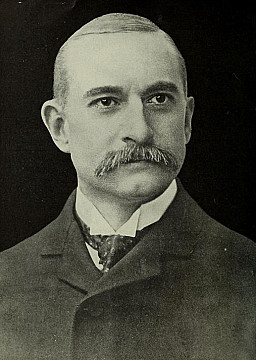James Jewett Stillman (1850-1918)
James Stillman, of New York; President of the National City Bank
He was born at Brownsville, Texas, founded by his father in 1848. He succeeded to his father's considerable business interests in 1872 which he grew to incorporate 16-banks in Texas and significant land holdings in the Rio Grande Valley. He teamed up with William Rockefeller, E.H. Harriman and Jacob Schiff to take control of the most important railroads in Texas. He came to New York as Chairman of the National City Bank (now Citibank), allying the bank with the Rockefellers, Standard Oil, and Kuhn, Loeb & Co. He led an expansion policy that by 1894 made National City the largest bank in the United States, the first to open foreign branches, and a leader in foreign exchange. By 1902, the bank was able to pay any sum of money to any city in the world within 24-hours. When Stillman died, he was known as "The Sphinx of Wall Street" and worth $77 million, making him one of the 100 wealthiest ever people in the States, but he left not one dime to charity. He rarely spoke and gave, "a general impression of cold arrogance".
He lived between 9 East 72nd Street in Manhattan; L'Hôtel du Parc Monceau in Paris; "The Ridge," his country home at Cornwall-on-Hudson where he made his family sit through two-hour formal dinners in silence; and, "Oaklawn" on Narragansett Ave., Newport, that he purchased from Charles Handy Russell. He owned a yacht, Wanderer, and was a collector of Japanese art and literature. His wife - who he considered mentally imbalanced - found life with him unbearable and separated from him in the 1890s when she moved to Europe. In turn, he forbade her from ever speaking to him or their children again. In 1918, he came in at 13th (tied with Charles M. Schwab, Daniel Guggenheim, Thomas F. Ryan and J.P. Morgan, Jr.) on the first ever Forbes Rich List with an estimated $70-million.
He lived between 9 East 72nd Street in Manhattan; L'Hôtel du Parc Monceau in Paris; "The Ridge," his country home at Cornwall-on-Hudson where he made his family sit through two-hour formal dinners in silence; and, "Oaklawn" on Narragansett Ave., Newport, that he purchased from Charles Handy Russell. He owned a yacht, Wanderer, and was a collector of Japanese art and literature. His wife - who he considered mentally imbalanced - found life with him unbearable and separated from him in the 1890s when she moved to Europe. In turn, he forbade her from ever speaking to him or their children again. In 1918, he came in at 13th (tied with Charles M. Schwab, Daniel Guggenheim, Thomas F. Ryan and J.P. Morgan, Jr.) on the first ever Forbes Rich List with an estimated $70-million.
Parents (2)
Categories
Share
American National Biography, Volume 20




